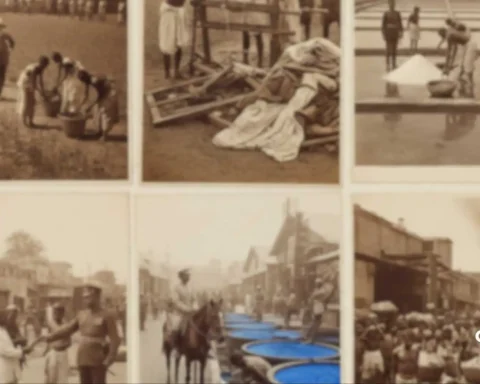International migration, or the movement of people across borders, has been an enduring aspect of history, particularly India’s history, which has shaped its interactions with the world. The history of migration from India starts with the ancient trade routes and cultural exchanges and ends with the large-scale movement of laborers under colonial rule to reach the now large Indian diaspora globally.
Indians have ventured across continents, establishing vibrant communities that contribute to the social, economic, and cultural landscapes of their host countries. There have been predominantly three waves of Indian migration over centuries which offer different experiences of the migrants and their lasting impact on global societies.
Table of Contents
Ancient and Medieval History of Migration from India
The history of migration from India can be traced back to the ancient period of Indus Valley civilization when merchants and traders of Indian origin traveled across South Asia, the Middle East, and Africa. Indian traders were active along the Silk Road and maritime routes, engaging in commerce with the Roman Empire, Southeast Asia, and the Arabian Peninsula. These trade connections facilitated not only economic exchanges but also the spread of Indian religions, languages, and cultural practices.
Buddhist monks and scholars from India played a key role in spreading Buddhism to China, Korea, and Japan. Indian influences were particularly strong in Southeast and South Asia, where Hindu and Buddhist kingdoms, such as the Srivijaya and Majapahit empires, flourished under Indian cultural and religious influence. Indian migrant population also settled in present-day Thailand, Sri Lanka, Cambodia, Indonesia, and Malaysia, contributing to the region’s linguistic and cultural landscape.
The medieval period saw further movements of Indians, particularly with the rise of Islamic rule in the subcontinent. The Delhi Sultanate and the Mughal Empire attracted Persian, Arab, and Central Asian settlers to India, while Indian scholars, artisans, and traders moved to the Middle East. Many Indian craftsmen and merchants traveled to Persia, the Ottoman Empire, and Central Asia, establishing trade networks and contributing to the global economy.
With the spread of Islam, Indian Sufi scholars and traders moved to regions such as East Africa and the Middle East. Indian communities, particularly those from Gujarat and Kerala, established themselves along the Swahili Coast of Africa, blending Indian and African cultural traditions.

Colonial Era: Indentured Labor and Overseas Migration
The most significant wave in the history of migration from India occurred during the colonial period, particularly under British rule. Following the abolition of slavery in the 19th century, the British, Dutch, and French empires transported millions of Indians as indentured laborers to work on plantations, railways, and infrastructure projects worldwide.
The British Raj facilitated the migration of laborers of Indian origin under the indenture system, sending workers to sugar plantations in the Caribbean (Trinidad & Tobago, Guyana, Suriname), Fiji, Mauritius, and South Africa. These laborers, primarily from Bihar, Uttar Pradesh, Tamil Nadu, and Bengal, were subjected to harsh working conditions for male and female migrants alike and contractual restrictions.
Despite the hardships, these international migrants, or indentured laborers managed to preserve their cultural identity, contributing to their host countries’ linguistic, religious, and culinary diversity. Today, the descendants of these laborers form significant Indian-origin communities in these nations.
Apart from indentured laborers and migrant workers, Indian traders and professionals migrated to East Africa, Burma (Myanmar), and Malaya (Malaysia and Singapore) to engage in commerce and administration. Gujarati and Sindhi merchants established flourishing business networks in Kenya, Uganda, and Tanzania, playing a crucial role in the colonial economy.
Post-Independence Migration (1947-present)
1947 partition and refugee movements
The partition of India in 1947 led to one of the largest mass migrations in history, with an estimated 15 million people displaced between India and the newly created nations of Pakistan and later Bangladesh (in 1971). Millions of Hindus, Sikhs, and Muslims crossed borders, leading to significant demographic shifts in both countries. India’s relationship with its neighbors has defined many aspects of its migration trends and foreign policy in the decades since.
1960s-1980s: Skilled international migration to the West
The post-independence period saw a shift in the history of migration from India, with an increasing number of Indian population moving to Western countries, particularly the United States, Canada, the United Kingdom, and Australia. In the 1960s and 1970s, highly skilled professionals, especially doctors, engineers, and scientists, migrated to the US and the UK due to favorable immigration policies.
The introduction of the US Immigration and Nationality Act of 1965 facilitated the entry of Indian professionals, leading to the growth of a highly educated and affluent Indian-American community. Similarly, the UK saw a wave of Indian emigrants, particularly from East African countries like Uganda, where Indian communities faced political persecution under leaders such as Idi Amin.
1990s-Present: IT boom and globalization
With the liberalization of India’s economy in 1991, a new wave of Indian migration emerged, driven by the rise of the Information Technology (IT) sector. Indian software engineers and IT professionals became highly sought after in Silicon Valley and other tech hubs worldwide. The H-1B visa program in the US allowed thousands of Indian engineers and tech workers to migrate, making Indian professionals a dominant force in the global IT industry.
Due to massive oil extraction, the Gulf region also became a major destination for Indian workers or workers of Indian origin, particularly in construction, healthcare, and domestic services. Today, millions of Indians live in the United Arab Emirates, Saudi Arabia, and Qatar, forming one of the largest expatriate communities in the region. Slightly more than half of India’s 17.9 million emigrants in 2020 lived in Persian Gulf countries, with 3.5 million in the UAE alone.
Impact of the Indian Diaspora
The Indian diaspora has significantly influenced the global economy, politics, and culture. Indian entrepreneurs, such as Sundar Pichai (Google) and Satya Nadella (Microsoft), have risen to leadership positions in multinational corporations. Politicians who are Indian emigrants, including Kamala Harris (Vice President of the United States) and Rishi Sunak (Prime Minister of the United Kingdom), highlight the political influence of the diaspora.
Remittances from Indian emigrants also play a crucial role in India’s economy, with India consistently being the top recipient of remittances globally. In 2021, official remittances from the Indian diaspora amounted to an estimated US $87 billion, supporting families and contributing to national economic growth.
Indian culture, from Bollywood to yoga and cuisine, has gained global recognition, fostering cross-cultural exchanges and strengthening India’s soft power. Festivals like Diwali and Holi are now celebrated in major cities worldwide, reflecting the widespread presence of the Indian diaspora.
Conclusion
The history of migration from India is a web of resilience, adaptation, and cultural exchange. Over centuries, Indian migrants have established thriving communities across the globe, contributing to their host nations while maintaining strong ties to their heritage. The Indian population has come to form the largest migrant population in the world since the United Nations started tracking countries of origin of the migrants in 1990, and the remittances that they send home are also the highest.
From ancient merchants and indentured laborers to modern-day professionals and entrepreneurs, the Indian diaspora continues to shape the global landscape. As migration patterns evolve, the enduring spirit of the Indian diaspora stands as a testament to the strength of human connection and the shared experiences of people across borders.

FAQs
What is the history of human migration in India?
The history of human migration in India dates back thousands of years, with early settlers arriving from East Africa and Central Asia, contributing to the region’s diverse cultural and genetic heritage. Over time, India saw external and internal migrations due to trade, invasions, and colocalization, leading to the exchange of cultural, religious, and economic practices.
When did people start migrating in India?
People in India began migrating as early as the ancient period, driven by trade, cultural exchange, and exploration. Evidence of migration can be traced back to the Indus Valley Civilization (around 2600 BCE) and subsequent movements of migrant workers along trade routes like the Silk Road and maritime networks.
Which country migrated most from India?
The United Arab Emirates (UAE) has the largest population of Indian migrant population, followed by the United States and Saudi Arabia. The Gulf region remains a major destination for migrant workers, especially Indian workers, especially in the construction, healthcare, and service sectors.









